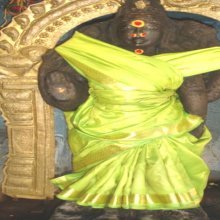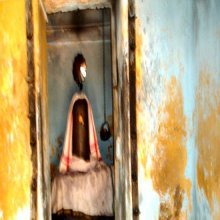Saree: 2 definitions
Introduction:
Saree means something in the history of ancient India, biology. If you want to know the exact meaning, history, etymology or English translation of this term then check out the descriptions on this page. Add your comment or reference to a book if you want to contribute to this summary article.
Images (photo gallery)
India history and geography
Source: Shodhganga: A translation of Jhaverchand Meghanis non translated folk talesSaree refers to “Traditional costume of an Indian woman”.—It is defined in the glossary attached to the study dealing with Gujarat Folk tales composed by Gujarati poet Jhaverchand Meghani (1896-1947)

The history of India traces the identification of countries, villages, towns and other regions of India, as well as mythology, zoology, royal dynasties, rulers, tribes, local festivities and traditions and regional languages. Ancient India enjoyed religious freedom and encourages the path of Dharma, a concept common to Buddhism, Hinduism, and Jainism.
Biology (plants and animals)
Source: Google Books: CRC World Dictionary (Regional names)Saree in Thailand is the name of a plant defined with Dalbergia parviflora in various botanical sources. This page contains potential references in Ayurveda, modern medicine, and other folk traditions or local practices It has the synonym Amerimnon cumingii (Benth.) Kuntze (among others).
Example references for further research on medicinal uses or toxicity (see latin names for full list):
· Flora Indica, or ‘Descriptions of Indian Plants’ ed. 1832 (1832)
· Journal of the Pharmaceutical Society of Japan (2006)
· Journal of Japanese Botany (1997)
· Plant Resources of South-East Asia (PROSEA) (1999)
· Hortus Bengalensis (1814)
· Fitoterapia (2009)
If you are looking for specific details regarding Saree, for example chemical composition, side effects, health benefits, extract dosage, pregnancy safety, diet and recipes, have a look at these references.

This sections includes definitions from the five kingdoms of living things: Animals, Plants, Fungi, Protists and Monera. It will include both the official binomial nomenclature (scientific names usually in Latin) as well as regional spellings and variants.
See also (Relevant definitions)
Starts with: Carira-cariripavam, Cariracakayam, Cariracampantam, Cariracampattu, Cariracastiram, Carirakkanappu, Carirakkattu, Cariram, Carirapantam, Carirapatanam, Carirappalutu, Carirappokku, Cariratarumam, Carirattirayam, Cariravaku, Cariravatai, Carirayattirai.
Ends with: Sunnasaree.
Full-text (+100): Marrupputavai, Kiragani, Cavukkali, Vanatantam, Pattupputaivai, Manitatpattiri, Tattuppattiri, Katikaraviciri, Tancavur-valaipu, Arakkuviciri, Natcattirappappali, Talampuccelai, Pantitalayakku, Cottuppappali, Tanka-valaipu, Netumulam, Curattu-tattupattiri, Punkavani, Mancalviciri, Cannaviciri.
Relevant text
Search found 13 books and stories containing Saree; (plurals include: Sarees). You can also click to the full overview containing English textual excerpts. Below are direct links for the most relevant articles:
The Feminine Psyche in the Poem of Kamala Das and < [July – September, 2003]
The Happenings of a Day < [March 1939]
Journey for Light < [April – June, 1993]
Tiruvaymoli (Thiruvaimozhi): English translation (by S. Satyamurthi Ayyangar)
Pasuram 9.7.7 < [Section 7 - Seventh Tiruvaymoli (Em Kanal Akam)]
Pasuram 9.7.6 < [Section 7 - Seventh Tiruvaymoli (Em Kanal Akam)]
Pasuram 9.7.10 < [Section 7 - Seventh Tiruvaymoli (Em Kanal Akam)]
Folk Tales of Gujarat (and Jhaverchand Meghani) (by Vandana P. Soni)
Chapter 29 - Gai Vrat < [Part 3 - Kankavati]
Chapter 8 - Vismada! Visamda! < [Part 3 - Kankavati]
Chapter 5 - Maluva < [Part 1 - Saurashtra ni Rashdhar]
Puranic encyclopaedia (by Vettam Mani)
Lord Jhulelal: An Analytical Study (by Thakkar Harish Gopalji)
Part 6 - Concept of Akhand Jyot < [Chapter 4 - Analysis]


